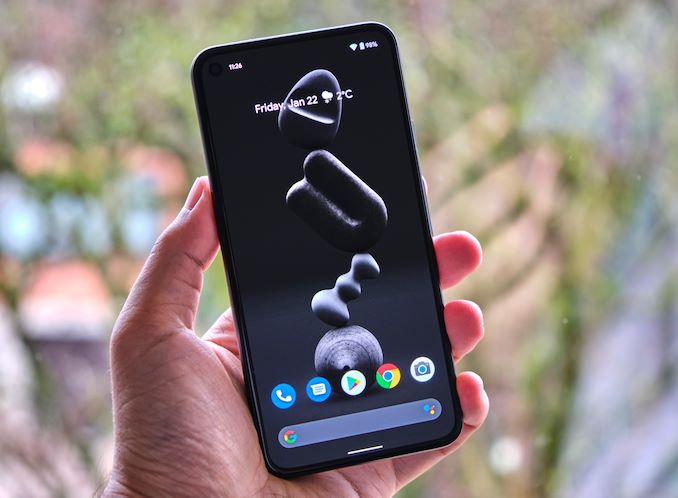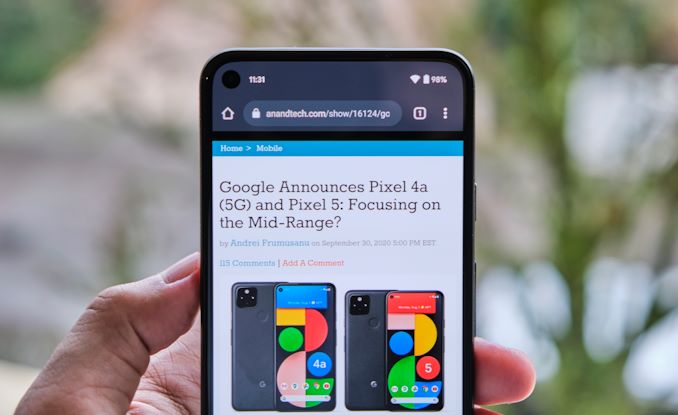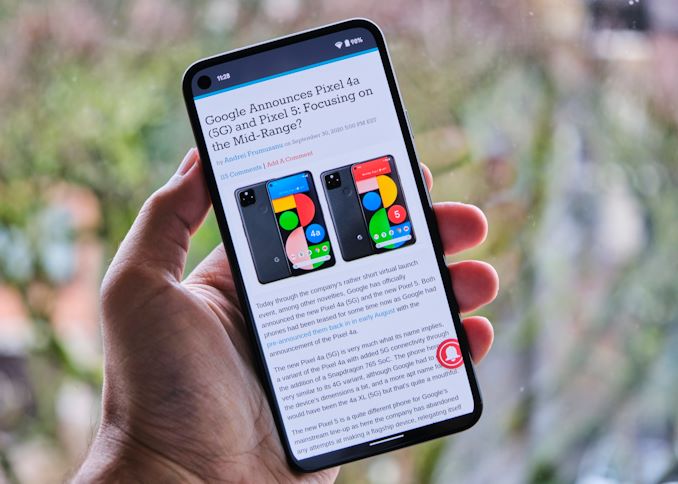The Google Pixel 5: A Mini-Review - Small Package, Small Value?
by Andrei Frumusanu on January 22, 2021 9:00 AM EST- Posted in
- Smartphones
- Mobile
- Pixel 5

It’s been a couple of months now since Google announced the Pixel 5 – Unfortunately we didn’t quite get to a timely review of the device due to other important industry coverage. Today I wanted to revisit the phone in a briefer format review, revisiting some important aspects of the phone such as performance, battery life, and add a few comments about the camera capabilities.
The Pixel 5 is a change of tactic for Google, with the company opting to go the route of a lower-cost “premium” or high mid-range component configuration, rather than setting up the Pixel 5 as an all-out flagship phone. Given the company’s product release cadence over the years, always releasing new phones towards the end of the year, just around the corner of the spring next-gen releases. This schedule had always been a disadvantage for Pixel flagships, so maybe Google’s change of strategy here to go for the mid-range is a more sensible approach.
| 2020 Google Pixels | ||||
| Pixel 4a | Pixel 4a (5G) | Pixel 5 | ||
| SoC | Snapdragon 730G 2x CA76 @ 2.2GHz 6x CA55 @ 1.8GHz Adreno 618 |
Snapdragon 765G 1x CA76 @ 2.4GHz 1x CA76 @ 2.2GHz 6x CA55 @ 1.8GHz Adreno 620 |
||
| DRAM | 6GB LPDDR4X | 8GB LPDDR4X | ||
| Storage | 128GB UFS 2.1 | 128GB | 128GB | |
| Display | 5.81" OLED 2340 x 1080 (19.5:9) |
6.2" OLED 2340 x 1080 (19.5:9) |
6.0" OLED 2340 x 1080 (19.5:9) 90Hz |
|
| Size | Height | 144.0 mm | 153.9 mm | 144.7 mm |
| Width | 69.4 mm | 74.0 mm | 70.4 mm | |
| Depth | 8.2 mm | 8.2 mm | 8.0 mm | |
| Weight | 143 grams | 168g (sub-6) 171g (mmWave) |
151g | |
| Battery Capacity | 3140mAh (typical) 18W Fast Charging |
3885mAh (typical) 18W Fast Charging |
4080mAh (typical) 18W Fast Charging |
|
| Wireless Charging | - | - | Yes | |
| Rear Cameras | ||||
| Main | 12.2MP 1.4µm Dual Pixel PDAF f/1.7 77° lens with OIS |
|||
| Telephoto | - | - | - | |
| Wide | - | 16MP 1.0µm f/2.2 107° Ultra-Wide Angle |
||
| Extra | - | - | - | |
| Front Camera | 8MP 1.12µm f/2.0 84° lens; fixed focus |
|||
| I/O | USB-C 3.5mm headphone jack |
USB-C | ||
| Wireless (local) | 802.11ac Wave 2 Wi-Fi Bluetooth 5.0 LE + NFC |
|||
| Cellular | Snapdragon LTE Integrated X15 (LTE Category 12/5) DL = 600Mbps UL = 150Mbps |
Snapdragon 5G Integrated X52 (LTE Category 18/13) DL = 1200 Mbps UL = 150 Mbps (5G NR Sub-6 + mmWave*) DL = 3700 Mbps UL = 1600 Mbps *excludes non-mmWave model of 4a(5G) *excludes mmWave in non-US markets |
||
| Other Features | Dual Speakers | Dual Speakers | Dual Speakers IP68 Rating |
|
| Dual-SIM | 1x nanoSIM + eSIM | |||
| Launch Price | $349 / 349£ / 349€ |
$499 / £499 / €499 $599* (mmWave) |
$699* / £599 / €629 |
|
Starting off with the SoC, as we’ve discussed it over the last few months, the big difference for the new Pixel 5 is that it comes with a “premium” range Snapdragon 765 chipset from Qualcomm, rather than using the contemporary Snapdragon 865 flagship SoC. This is undoubtedly a cost-cutting measure for Google to be able to achieve this new price point of $699 / €629.
The SoC should still be plenty performance for every-day usages thanks to the two Cortex-A76 big cores, with one of them clocking up to 2.4GHz and the other one at 2.2GHz, however it’s still going to be a notable downgrade compared to the flagship SoCs which employ both newer CPU cores as well as clocking them higher. The SoC’s Adreno 620 GPU is also going to be a key factor in the general performance of the Pixel 5, making some big gaming performance compromises that we’ll cover in more detail in the GPU section.
Google dons the Pixel 5 with 8GB of LPDDR4X memory and a singular storage option of 128GB, without any expandable storage.
The Pixel 5’s front design adopts the similar uniform bezel design introduced with the lower-cost Pixel 4a, and is a departure from the chin and forehead style of the previous generations, also avoiding the usage of odd camera notches. Instead, we have an in-screen camera cut-out in the top left corner, which works quite well. It’s definitely a much more modern design that we’ve seen in previous generation Pixel phones.
The actual display is a 2340 x 1080 OLED screen with a 90Hz refresh rate. This year, I’ve not seen any issues with the display panel as it’s quite high quality even though the specifications aren’t exactly up to par with 1440p 120Hz competitors.
At 6.0” diagonal and only 70.4mm phone width however, the 1080p resolution isn’t an issue as the pixel density is very viable.
The camera setup on the Pixel 5 is quite simple, but Google made some important changes in the secondary module compared to last generation, replacing the dedicated telephoto module with an ultra-wide camera. It’s always possible to pinch-to-zoom to get closer to your subject (although with quality drop), however it’s not possible to pinch out to get a wider field of view if you don’t have the camera hardware for it. This was a large criticism of the previous generation Pixel phones as they had been the only relevant devices in the market not actually using a UWA module. The camera here is a 16MP 1.0µm unit with an f/2.2 aperture and a 107° FoV – not the widest out there, but still plenty competitive and very usable.
The main camera module continues to be a 12.2MP 1.4µm sensor module with f/1.7 optics and OIS – it’s the same module we’ve seen in the Pixel 4 and an overall camera formula we haven’t seen changed in many generations of Pixel phones. Google this year advertised improvements in the HDR algorithms – although you can’t say that the overall camera experience is as ground-breaking as it was a few years ago.
The one regard where the Pixel 5 really differentiates itself from almost any other contemporary phone in the market is its build materials and build-quality. Unlike the usual glass sandwiches of recent years, the Pixel 5 uses an aluminium unibody. It’s not naked aluminium as it has a special plastic coating on it, which gives it a grippy feel, but also isn’t exactly the same as a full plastic phone.
The special thing about the aluminium body is that Google still managed to employ wireless charging though a cut-out in the frame, which of course is invisible to the user due to the plastic coating on top of it.
Generally, I found the design of the Pixel 5 to be pretty good and it had excellent ergonomics. It’s very rare to have good small phones nowadays, and at only 70.4mm width and 151g weight, the Pixel 5 does quite well to address this part of the market. Google opted not to release a Pixel 5 XL this year, so you don’t really have a choice if you prefer a larger variant of the phone – you’d have to go with the Pixel 4a XL, or another competitor device.













104 Comments
View All Comments
Flunk - Friday, January 22, 2021 - link
Correction, the US version of the Nord uses the slightly inferior Snapdragon 690 SoC so it should be slower. It's still crazy cheap.Fulljack - Sunday, January 24, 2021 - link
snapdragon 690 uses newer cortex-a77 while snapdragon 765g still uses cortex-a76, clockwise it's slower by 16,66% but the ipc gain is 20%, so snapdragon 690 are actually faster. qualcomm products naming are weird, I knowiphonebestgamephone - Monday, January 25, 2021 - link
The gpu would probably be slower on 690.Spunjji - Monday, January 25, 2021 - link
@iphonebestgamephone - correct, the 690 uses the Adreno 619L which is actually around 50% slower than the 620.Qualcomm's naming system is b a n a n a s
eastcoast_pete - Monday, January 25, 2021 - link
For how long does OnePlus guarantee software (system and security) updates for? That's an important part of a phone's value proposition. And, while it pains me as an Android user, not leaving owners of older phone models behind is something Apple actually does well. I was, however, pleasantly surprised when Xiaomi made an OS update for my decidedly middle-class (at time of purchase) phone available even after >2.5 years of ownership. I took note of that, and it might help convince me to buy another phone from them.Arbie - Saturday, January 23, 2021 - link
The Pixel 5 also has a much larger battery than the 4a. Which is why I would have considered it as an eventual replacement for that.Except they removed the headphone jack so no dice.
rahvin - Saturday, January 23, 2021 - link
Those aren't the only differences, the battery is quite a bit longer lasting (owing to the extra 200mah deleting the 3.5mm jack). The glass is also GG6 versus GG3 like on the pixel 2/4a5G, it's the smoothest glass I've ever encountered, if I set the pixel 5 down (screen down) on a table that is even slightly out of level it will slide off. It's like I'm carrying around an air table puck. The GG6 is also significantly harder to scratch based on what's happened to mine since I got it. I honestly wouldn't have expected that much improvement in glass between GG3 and GG6 but IMO there is.Spunjji - Monday, January 25, 2021 - link
Same conclusion I came to. The 2GB of RAM isn't really useful. The 90Hz screen would be *nice*, and the same goes for IP68 rating - but you can get most or all of those with other companies' $400 phones. I haven't used wireless charging since my Palm Pre 2 🤷♂️BrokePeopleBuyBadStuff - Monday, January 25, 2021 - link
...yeah that stuff isn't free and it's faster than last years BUDGET phone. Don't get me wrong, it's still a budget phone but yeah...broke people get broke joke phones I guess.Great_Scott - Monday, January 25, 2021 - link
The Chart says that the Pixel 4a (5G) is the phone to get of the three.